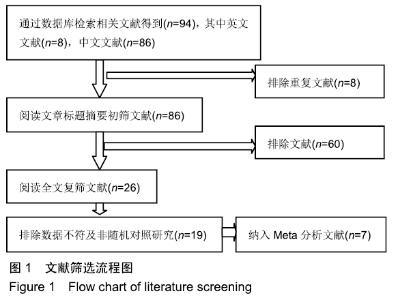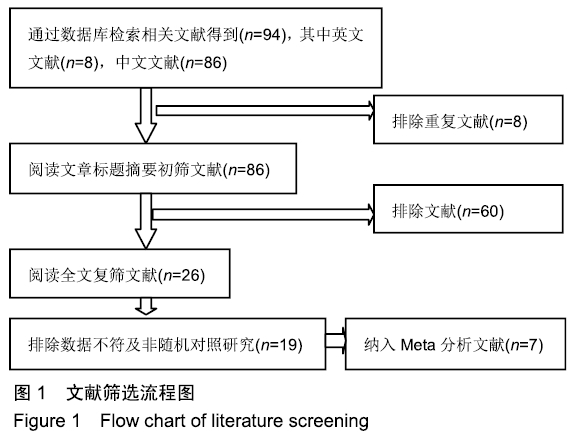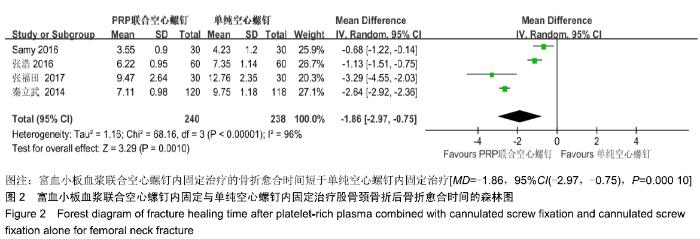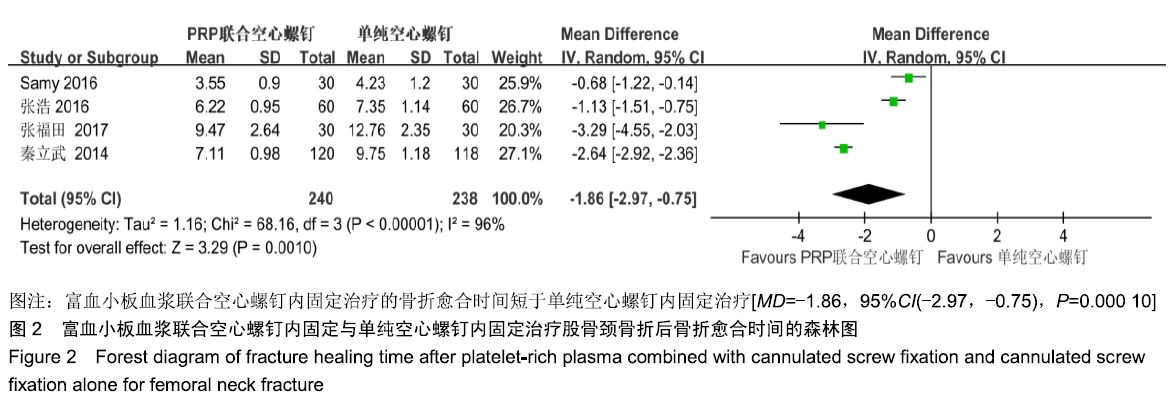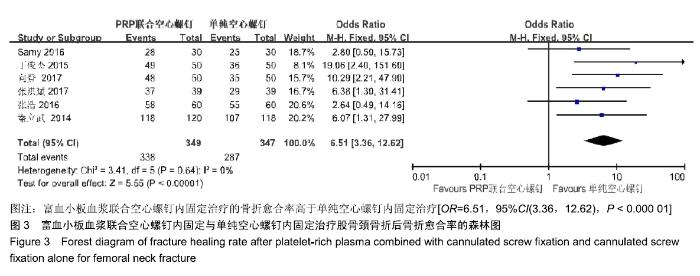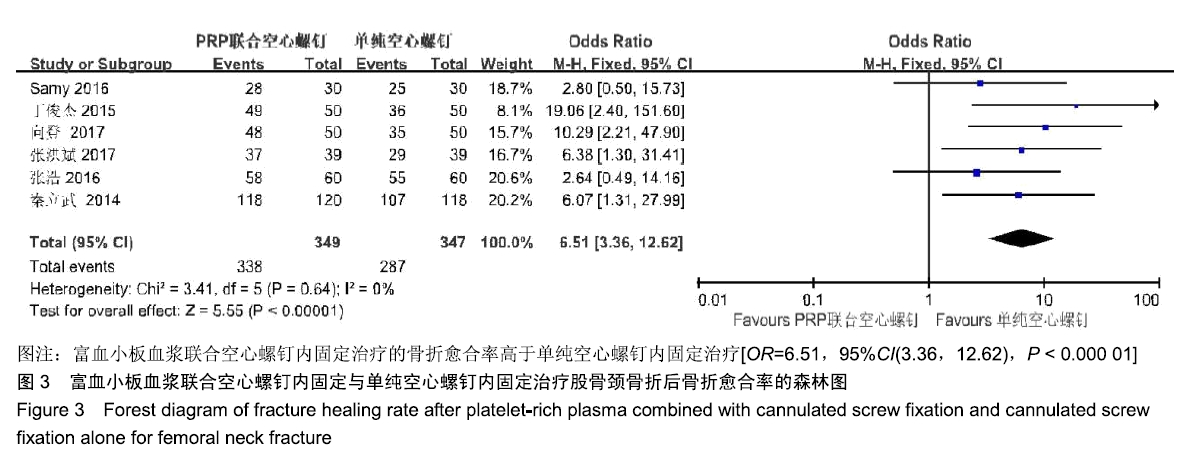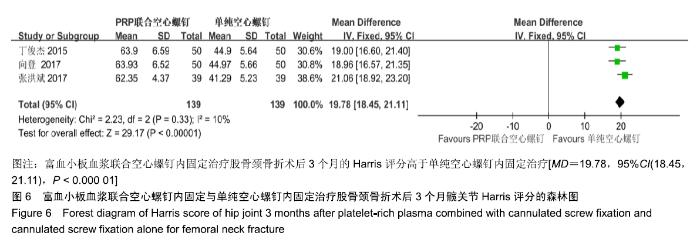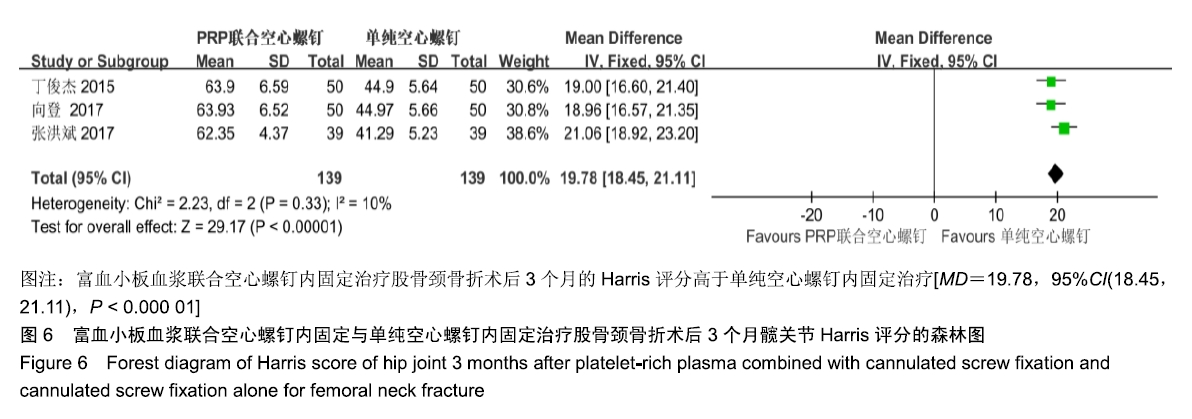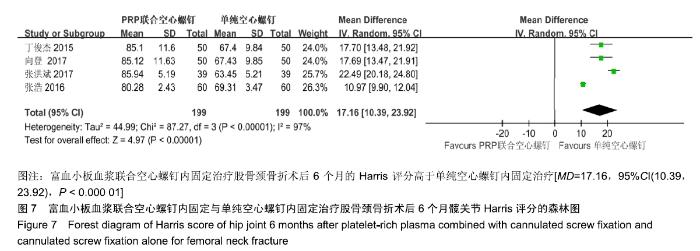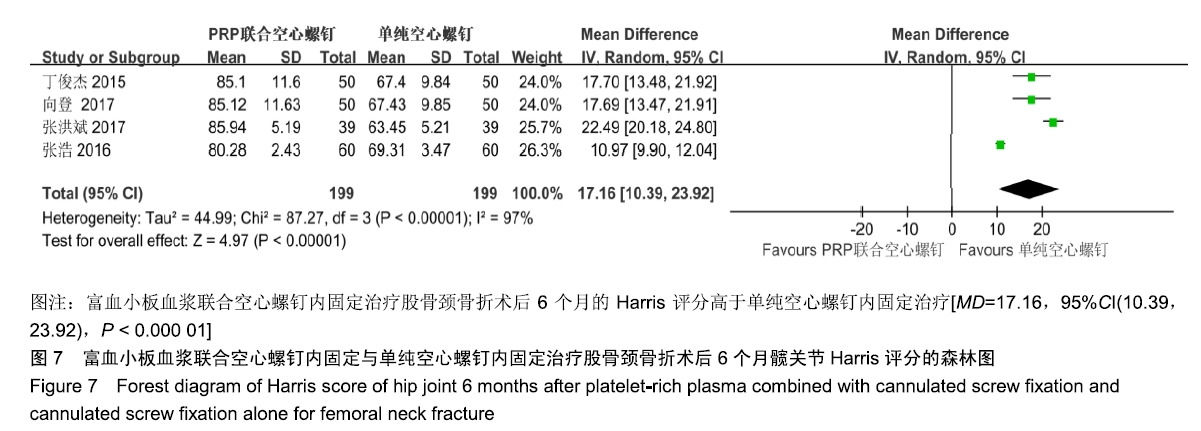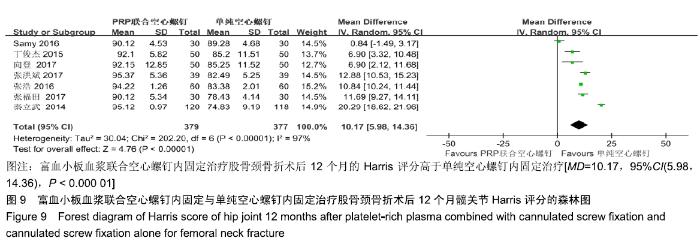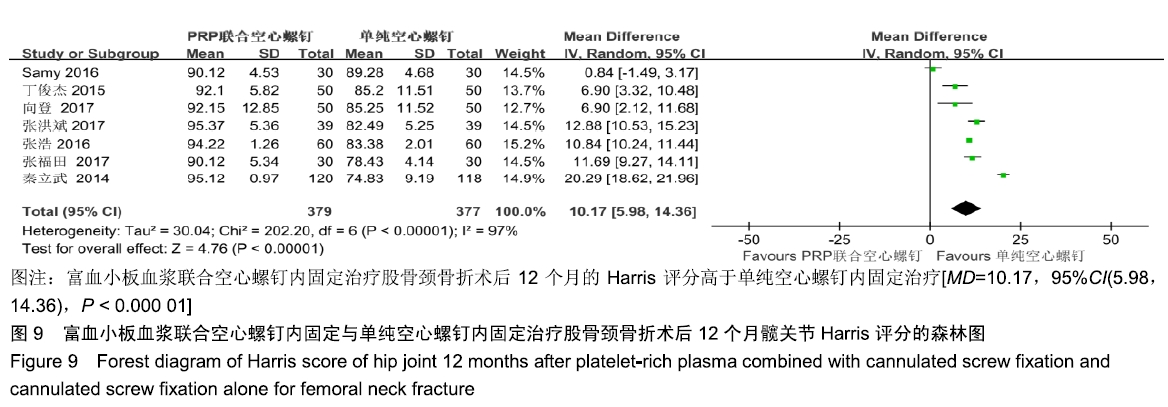Chinese Journal of Tissue Engineering Research ›› 2020, Vol. 24 ›› Issue (3): 469-476.doi: 10.3969/j.issn.2095-4344.2421
Previous Articles Next Articles
Meta-analysis of the efficacy of platelet-rich plasma combined with cannulated screw fixation for the treatment of femoral neck fracture
Chen Xiang, Wei Dong, Zhao Ruipeng, Li Pengcui, Wei Xiaochun
- Department of Orthopedics, Second Hospital of Shanxi Medical University, Taiyuan 030001, Shanxi Province, China
-
Received:2019-05-07Revised:2019-05-22Accepted:2019-06-29Online:2020-01-28Published:2019-12-27 -
Contact:Wei Xiaochun, MD, Professor, Department of Orthopedics, Second Hospital of Shanxi Medical University, Taiyuan 030001, Shanxi Province, China -
About author:Chen Xiang, Master candidate, Department of Orthopedics, Second Hospital of Shanxi Medical University, Taiyuan 030001, Shanxi Province, China -
Supported by:the National International Science and Technology Cooperation Project, No. 2015DFA33050; the Shanxi Province Key Research and Development Plan (Guide) Project, No. 201803D421066; the Shanxi Science and Technology Basic Condition Platform Project, No. 201705D121010
CLC Number:
Cite this article
Chen Xiang, Wei Dong, Zhao Ruipeng, Li Pengcui, Wei Xiaochun. Meta-analysis of the efficacy of platelet-rich plasma combined with cannulated screw fixation for the treatment of femoral neck fracture[J]. Chinese Journal of Tissue Engineering Research, 2020, 24(3): 469-476.
share this article
Add to citation manager EndNote|Reference Manager|ProCite|BibTeX|RefWorks
| [1] HU X, LIU BJ, WEN XM, et al.Clinical observation of closed reduction and compression cannulated screw fixation for the treatment of femoral neck fracture in young and middle-aged patients. Zhongguo Gu Shang.2018;31(2):111-114. [2] 张保中,常晓.股骨颈骨折的分型及治疗方法的选择[J].中国骨伤, 2016,29(11):973-976. [3] 王斌.股骨颈骨折的治疗综述[J].中国医药指南,2018,16(10): 35-37. [4] 秦立武,姜红江,黄相杰,等.富血小板血浆联合空心钉治疗股骨颈骨折的疗效观察[J].中国骨与关节损伤杂志,2014,29(12): 1250-1251. [5] SIMMAN R, HOFFMANN A, BOHINC RJ, et al.Role of Platelet-Rich Plasma in Acceleration of Bone Fracture Healing.Ann Plast Surg.2008;61(3):337-344. [6] GRIFFIN XL, ACHTEN J, PARSONS N, et al.Platelet-rich therapy in the treatment of patients with hip fractures: a single centre, parallel group, participant-blinded, randomised controlled trial.BMJ Open.2013;3(6):e002583-e002583. [7] ORYAN A, ALIDADI S, MOSHIRI A.Platelet-rich plasma for bone healing and regeneration. Expert Opin Biol Ther. 2016; 16(2):213-232. [8] MARTINEZ-MARTINEZ A, RUIZ-SANTIAGO F, GARCIA- ESPINOSA J.Platelet-rich plasma: myth or reality? Radiologia. 2018;60(6):465-475. [9] GUZEL Y, KARALEZLI N, BILGE O, et al.The biomechanical and histological effects of platelet-rich plasma on fracture healing.Knee Surg Sports Traumatol Arthrosc. 2015;23(5): 1378-1383. [10] 马超,王文波.空心螺钉治疗股骨颈骨折的研究进展[J].创伤外科杂志,2018,20(4):312-315,317. [11] ROFFI A, DI MATTEO B, KRISHNAKUMAR GS, et al. Platelet-rich plasma for the treatment of bone defects: from pre-clinical rational to evidence in the clinical practice. A systematic review. Int Orthop.2017;41(2):221-237. [12] SAMY AM.The role of platelet rich plasma in management of fracture neck femur: new insights.Int Orthop. 2016;40(5): 1019-1024. [13] 丁俊杰,丁涛,董卫东.富血小板血浆对股骨颈骨折患者骨折愈合及股骨头坏死的影响[J].海南医学,2015,26(19):2912-2913. [14] 向登,林炎水,贺军,等.富血小板血桨对股骨颈骨折愈合及股骨头坏死治疗效果的影响[J].西部医学,2017,29(1):103-105,109. [15] 张洪斌.探讨应用富血小板血桨(PRP)对股骨颈骨折愈合及股骨头坏死治疗效果的影响[J].中外医疗,2017,36(31):100-102. [16] 张浩,龙亨国.富血小板血浆对股骨颈骨折愈合及髋关节功能恢复的120例临床研究[J].黑龙江中医药,2016,45(2):21-22. [17] 张福田,孔祥全,张桂红,等.富血小板血浆与空心钉锁定钢板治疗股骨颈骨折[J].中国矫形外科杂志, 2017,25(14):1277-1281. [18] FLORSCHUTZ AV,LANGFORD JR,HAIDUKEWYCH GJ,et al.Femoral neck fractures: current management.J Orthop Trauma. 2015;29(3):121-129. [19] GIERER P, MITTLMEIER T.Femoral neck fracture. Unfallchirurg. 2015;118(3):259-269; quiz 270. [20] 纪小枫,尚希福,史国光,等.闭合复位经皮空心钉内固定治疗股骨颈骨折的体会[J].中国骨与关节损伤杂志,2015,30(8):863-864. [21] 陈志军,杨彪,张大华. PRP联合闭合复位空心螺钉内固定治疗股骨颈骨折[J].局解手术学杂志,2016, 25(3):195-198. [22] 陈相如,阳君.空心钉三角放射状内固定治疗股骨颈骨折[J].中国医药科学,2015,12(5): 105-107,174. [23] 林凯.空心加压螺钉内固定术结合自体富血小板血浆治疗中青年股骨颈骨折的疗效[J].中国社区医师,2017,33(1):56-57. [24] KRAEUTLER MJ, GARABEKYAN T, MEI-DAN O.The use of platelet-rich plasma to augment conservative and surgical treatment of hip and pelvic disorders.Muscles Ligaments Tendons J.2016;6(3): 410-419. [25] HSU WK, MISHRA A, RODEO SR, et al.Platelet-rich plasma in orthopaedic applications: evidence-based recommendations for treatment.J Am Acad Orthop Surg.2013; 21(12):739-748. [26] DHILLON RS, SCHWARZ EM, MALONEY MD.Platelet-rich plasma therapy - future or trend?. Arthritis Res Ther. 2012; 14(4):219. [27] 福嘉欣,王树森.自体富血小板血浆治疗骨关节与运动损伤疾病的机制与应用[J].中国组织工程研究,2017,21(30):4908-4914. [28] 赫兰学,马震卓,丁雪峰,等.富血小板血浆促进骨折愈合机制及研究进展[J].中国继续医学教育,2016,8(11):77-78. [29] 汤其元,马亚萍,张斌,等.骨组织再生工程中富血小板血浆的应用与研究进展[J].中国组织工程研究,2019,23(4):111-119. [30] SANCHEZ M,ANITUA E,CUGAT R,et al.Nonunions treated with autologous preparation rich in growth factors.J Orthop Trauma.2009;23(1):52-59. [31] 张礼科,朱德帅.骨折内固定术与全髋关节置换术治疗老年股骨颈骨折的临床效果比较[J].养生保健指南,2019,18(20):62. [32] 瞿国峰,邹毅,叶茂,等.骨折内固定术与全髋关节置换术治疗老年股骨颈骨折的临床效果比较[J]. 湖北民族学院学报(医学版), 2019,36(1):45-48. [33] 王玥,闫红旗,方伟,等.空心加压螺钉内固定结合自体富血小板血浆骨折端注射治疗中青年人股骨颈骨折[J].中国基层医药, 2016, 23(23):3613-3615. [34] 朱海涛,丁德刚,朱余龙,等.闭合复位空心螺钉内固定结合富血小板血浆(PRP)髋关节内注射治疗中青年股骨颈骨折的疗效分析[J].医药前沿,2013,35(30):72-73. [35] 袁凯旋,罗鹏波,张长青.全螺纹空心螺钉治疗股骨颈骨折研究进展[J].国际骨科学杂志,2019,40(3):140-142. [36] GJERTSEN JE,FEVANG JM,MATRE K,et al.Clinical outcome after undisplaced femoral neck fractures.Acta Orthop. 2011; 82(3):268-274. [37] ZHANG N,WU YP,QIAN SJ,et al.Research progress in the mechanism of effect of PRP in bone deficiency healing. ScientificWorldJournal.2013;2013:134582. [38] BATISTA MA,LEIVAS TP,RODRIGUES CJ,et al.Comparison between the effects of platelet-rich plasma and bone marrow concentrate on defect consolidation in the rabbit tibia. Clinics (Sao Paulo).2011;66(10):1787-1792. |
| [1] | Du Xiupeng, Yang Zhaohui. Effect of degree of initial deformity of impacted femoral neck fractures under 65 years of age on femoral neck shortening [J]. Chinese Journal of Tissue Engineering Research, 2021, 25(9): 1410-1416. |
| [2] | Chen Junming, Yue Chen, He Peilin, Zhang Juntao, Sun Moyuan, Liu Youwen. Hip arthroplasty versus proximal femoral nail antirotation for intertrochanteric fractures in older adults: a meta-analysis [J]. Chinese Journal of Tissue Engineering Research, 2021, 25(9): 1452-1457. |
| [3] | Chen Jinping, Li Kui, Chen Qian, Guo Haoran, Zhang Yingbo, Wei Peng. Meta-analysis of the efficacy and safety of tranexamic acid in open spinal surgery [J]. Chinese Journal of Tissue Engineering Research, 2021, 25(9): 1458-1464. |
| [4] | Hu Kai, Qiao Xiaohong, Zhang Yonghong, Wang Dong, Qin Sihe. Treatment of displaced intra-articular calcaneal fractures with cannulated screws and plates: a meta-analysis of 15 randomized controlled trials [J]. Chinese Journal of Tissue Engineering Research, 2021, 25(9): 1465-1470. |
| [5] | Huang Dengcheng, Wang Zhike, Cao Xuewei. Comparison of the short-term efficacy of extracorporeal shock wave therapy for middle-aged and elderly knee osteoarthritis: a meta-analysis [J]. Chinese Journal of Tissue Engineering Research, 2021, 25(9): 1471-1476. |
| [6] | Wang Yongsheng, Wu Yang, Li Yanchun. Effect of acute high-intensity exercise on appetite hormones in adults: a meta-analysis [J]. Chinese Journal of Tissue Engineering Research, 2021, 25(8): 1305-1312. |
| [7] | Jiang Hongying, Zhu Liang, Yu Xi, Huang Jing, Xiang Xiaona, Lan Zhengyan, He Hongchen. Effect of platelet-rich plasma on pressure ulcers after spinal cord injury [J]. Chinese Journal of Tissue Engineering Research, 2021, 25(8): 1149-1153. |
| [8] | Kong Desheng, He Jingjing, Feng Baofeng, Guo Ruiyun, Asiamah Ernest Amponsah, Lü Fei, Zhang Shuhan, Zhang Xiaolin, Ma Jun, Cui Huixian. Efficacy of mesenchymal stem cells in the spinal cord injury of large animal models: a meta-analysis [J]. Chinese Journal of Tissue Engineering Research, 2021, 25(7): 1142-1148. |
| [9] | Huang Dengcheng, Wang Zhike, Cao Xuewei. Intravenous, topical tranexamic acid alone or their combination in total knee arthroplasty: a meta-analysis of randomized controlled trials [J]. Chinese Journal of Tissue Engineering Research, 2021, 25(6): 948-956. |
| [10] | Li Yan, Wang Pei, Deng Donghuan, Yan Wei, Li Lei, Jiang Hongjiang. Electroacupuncture for pain control after total knee arthroplasty: a meta-analysis [J]. Chinese Journal of Tissue Engineering Research, 2021, 25(6): 957-963. |
| [11] | He Xiangzhong, Chen Haiyun, Liu Jun, Lü Yang, Pan Jianke, Yang Wenbin, He Jingwen, Huang Junhan. Platelet-rich plasma combined with microfracture versus microfracture in the treatment of knee cartilage lesions: a meta-analysis [J]. Chinese Journal of Tissue Engineering Research, 2021, 25(6): 964-969. |
| [12] | Hua Haotian, Zhao Wenyu, Zhang Lei, Bai Wenbo, Wang Xinwei. Meta-analysis of clinical efficacy and safety of antibiotic artificial bone in the treatment of chronic osteomyelitis [J]. Chinese Journal of Tissue Engineering Research, 2021, 25(6): 970-976. |
| [13] | Zhan Fangbiao, Cheng Jun, Zou Xinsen, Long Jie, Xie Lizhong, Deng Qianrong. Intraoperative intravenous application of tranexamic acid reduces perioperative bleeding in multilevel posterior spinal surgery: a meta-analysis [J]. Chinese Journal of Tissue Engineering Research, 2021, 25(6): 977-984. |
| [14] | Zhong Yuanming, Wan Tong, Zhong Xifeng, Wu Zhuotan, He Bingkun, Wu Sixian. Meta-analysis of the efficacy and safety of percutaneous curved vertebroplasty and unilateral pedicle approach percutaneous vertebroplasty in the treatment of osteoporotic vertebral compression fracture [J]. Chinese Journal of Tissue Engineering Research, 2021, 25(3): 456-462. |
| [15] | Li Yang, Zhang Mingyong. Meta-analysis of the effect of double Endobutton and clavicular hook plate on the treatment of acromioclavicular dislocation [J]. Chinese Journal of Tissue Engineering Research, 2021, 25(3): 463-470. |
| Viewed | ||||||
|
Full text |
|
|||||
|
Abstract |
|
|||||
